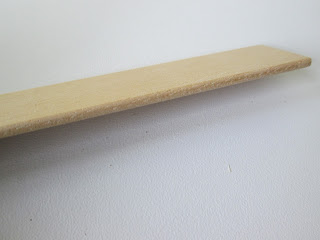Months ago I made up two sets of Mini Mundus Books which I really liked doing and I liked the finished result but they are £25 for a kit yielding 84 books. This works out around 30p per book; so not a financial possibility for the quantity I need. Also, I can't have a library filled with the same sets of books.
If you want to see those books click on Mini Mundus which I hope will take you to the post. Failing that click on 'library' label in left margin of blog and scroll through those posts until you get to it or find it by date order of posts - 25th August 2015 (wow, so long ago)
Off I toddled to search on line for free printies for 1/12ths. I know there is ton of that stuff out there so I easily found and saved a few likely pages and I began mass production. So off to step one of bookmaking as per me.
Download the printie and print on ordinary A4 paper.
I then coated the print with matt Mod Podge to stiffen the paper, protect the print and give a slight sheen to the covers. I do find it makes the inkjet ink run but I don't think it matters for this purpose as nine tenths of the book will never be seen again - in reality this will be 500 book spines I am making!!
When it was bone dry I cut out the covers.
I began filling the first couple of books with long strips of copy paper which I concertina folded and glued into the book. I find concertina folding fiddly at this size as it needs to be spot on accurate for a good result. The alternative method was to cut double page size pieces, fold in half and glue those together to form the inners.
This worked fine but the process needed to be speeded up. Thinking about the Mini Mundus set and the speed and ease of filling covers with balsa wood I searched around for something the right thickness for my printies. Out came old faithful - the grey cardboard.
The appearance of the end result again doesn't matter for my purposes - loose pages obviously look better than the cardboard but neither will ever be seen.
 |
| pages |
 |
| cardboard |
There was also a downside to the ones with pages in - they stopped the books staying neatly closed.
I intend to glue sets of books together to make them easier to load onto the shelves. They are not things of beauty but hopefully with some nicer books mixed in here and there they will do the job - Elizabth is collecting 17th and 18th century texts after all so scruffy is fine!
On my searches I also paid (!!) £1.91 to download this music book printout. I am going to make a set of six to stack in the music room somewhere.
 |
| Concertina fold and glue |
 |
| Mod Podged the cover |
 |
| I made better corners on the next books |
I came across a lot of nice maps in the free printies so I decided to do a page of those too. This time no Mod Podge was involved but I did paint the back of the paper with a mucky coloured water colour wash to get rid of the bright white paper. When bone dry the maps were rolled around a toothpick and relaxed a little, then re-rolled, not too tightly and not all the same. The roll was fixed with a spot of glue and stacked (for now) in a book box. They look good beside the library desk.
PS: If you do ever have this book challenge - look forward to it.... no, really. By day two I had found ways of speeding up the mass production process and found I could make little groups of books in very quick time as long as each book didn't need to be a perfect specimen which, of course, they don't. Let go of that requirement and you end up with great looking little groups of books that look just perfect on the shelves of a bookcase.
(24/05/17)







































